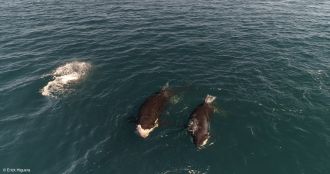Scientists have spotted orcas hunting a nursery of juvenile sharks for the first time, flipping them upside down and feeding on their energy-rich livers, a discovery that hints at changing seasonal diets of killer whales.
Orcas have previously only been seen preying on adult great white sharks in South Africa, with one shark providing enough food for an entire pod.
Now, researchers have documented a pod of orcas in the Gulf of California following a special hunting technique to repeatedly target juvenile great whites, flipping them and taking out their livers to share among themselves.
The orcas may be taking advantage of a local nursery of less experienced juvenile sharks that are easier to catch and subdue, scientists say in a new study.
Dubbed “Moctezuma’s pod”, these orcas may also be taking advantage of warming waters in the Gulf altering shark nursery areas, the researchers suspect.
The study suggests that orcas may be hunting great white sharks more often than previously thought.
“I believe orcas that eat elasmobranchs – sharks and rays – could eat a great white shark if they wanted to, anywhere they went looking for one,” said marine biologist Erick Higuera Rivas, an author of the study published in the journal Frontiers in Marine Science.
“This behaviour is a testament to orcas’ advanced intelligence, strategic thinking, and sophisticated social learning, as the hunting techniques are passed down through generations within their pods.”
The researchers describe the orca pod carrying out two hunts during which they kill three white sharks.
The first hunt in August 2020 involved five orcas pursuing a juvenile white shark.
Researchers observed that the orcas pushed the shark to the surface and worked together to turn it upside down.
The pod took the shark underwater and reappeared with its liver in their mouths.
The pod was later discovered hunting a second juvenile shark in the same manner.
In August 2022, the researchers found orcas following the same pattern of pushing a juvenile white shark onto its back and then up to the surface. The orcas were spotted eating the shark’s liver.
Flipping a shark upside down is known to induce a state called tonic immobility, which means paralysing it by changing its awareness of its surroundings.
“This temporary state renders the shark defenceless, allowing the orcas to extract its nutrient-rich liver and likely consume other organs as well before abandoning the rest of the carcass,” Dr Rivas explained.

The latest findings indicate that orcas might have developed a special technique to induce this state of immobility, which minimises the chances of being bitten by the shark. “Adult white sharks react quickly to hunting orcas, completely evacuating their seasonal gathering areas and not returning for months,” Salvador Jorgensen, another study author from California State University, said. “But these juvenile white sharks may be naive to orcas.”
“We just don't know yet whether white shark anti-predator flight responses are instinctual or need to be learned.”
The researchers also suspect climate events like El Niño may have altered white shark nursery areas and increased their presence in the Gulf of California. This may be exposing the sharks to this pod, and each new generation of juveniles could be a vulnerable seasonal target.
“Future studies should continue to monitor the shifting ranges and aggregation sites of juvenile white sharks driven by ocean warming,” the study noted.
Scientists warn this common supplement could be silently harming your heart
Category 6 is the new hurricane normal, scientists warn
Here’s the reason why some humans grow horns
Country with best nature connectedness revealed - Britain ranked one of the worst
Chimpanzees mirror human thought processes in new study
What to do if you encounter a bear in Japan, according to new study







